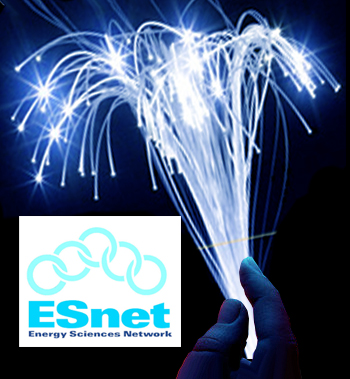Contact: Linda Vu, (510) 495-2402, [email protected]
ESNet, the U.S. Department of Energy’s Energy Science Network headquartered at Lawrence Berkeley National Laboratory, has completed hardware installation for the Science Data Network (SDN), the nation’s first dynamic-circuit network dedicated solely to scientific research.

“SDN provides the means to dynamically provision guaranteed, high-capacity bandwidth between any two science facilities for DOE researchers to access time-sensitive applications and exchange large datasets,” says Steve Cotter, ESnet Department Head. “This on-demand, hybrid-packet and circuit-switched network capability is currently not available commercially, so we built our own unique network to meet the demanding requirements of the research and education community.”
The new network consists of multiple 10-gigabit optical circuits, each capable of transferring the equivalent of 500 hours of digital music per second; the network has extensive reach and enables close collaboration among DOE laboratories and research facilities across the United States, as well as scientists using international research networks in Asia, Australia, Europe, and North and South America.
“As science trends toward fewer but larger, more-sophisticated scientific instruments, collaborations become increasingly more distributed,” says Cotter, “and the ability to move large volumes of data from point to point across dedicated channels becomes more important. SDN provides that ability.”
Joe Burrescia, ESnet General Manger, says SDN was conceived and built by ESnet network engineers as a dedicated platform for DOE’s On-Demand Secure Circuits and Advance Reservation System (OSCARS) – a network service that lets users reserve bandwidth for latency-sensitive (time-sensitive) high-speed data transfers.
Before the completion of SDN, DOE researchers used OSCARS to reserve bandwidth on ESnet’s Internet Protocol (IP) network, which also handles day-to-day operational traffic like e-mails and video conferencing. Because an IP network is connected to many computers and can have multiple endpoints, information traveling on this highway must pass through a number of gateways, or routers, to ensure that it reaches its destination. Like a toll road during rush hour, the flow of information can slow significantly when there is a lot of traffic on the IP network.
According to Jim Gagliardi, Technical Lead of ESnet’s Operations and Deployment Group, SDN works like an expressway, providing an uncongested path between two end points. Researchers now have available a network resource optimized for moving large datasets across the wide-area network from one remote host to another.
“Our traffic models show that the exponential growth of data traffic for scientific communities like high-energy physics and climate change will soon overwhelm our high-speed IP network,” says Burrescia. “By deploying SDN, ESnet is able to move this traffic off of the IP network and onto this highly-scalable infrastructure.”
ESnet’s IP and SDN networks together make up ESnet4, DOE’s next-generation science data transport network. To expand the network’s reach and increase site redundancy, eight new hub locations were also added to ESnet4. The new sites include Boise, Boston, Cleveland, El Paso, Houston, Kansas City, Mo., Los Angeles, and New York. ESnet4 now has 19 hub locations across the country, as well as a presence at most major peering facilities, where internet service providers exchange traffic.
Additional information
ESnet is funded by the DOE Office of Science to provide network and collaboration services in support of the agency’s research missions. A pioneer in providing high-bandwidth, reliable connections, ESnet enables researchers at national laboratories, universities and other institutions to communicate with each other using the collaborative capabilities needed to address some of the world’s most important scientific challenges. The ESnet Department is part of the Computational Research Division at Berkeley Lab. For more information about ESnet visit http://www.es.net/.
Berkeley Lab is a U.S. Department of Energy national laboratory located in Berkeley, California. It conducts unclassified scientific research and is managed by the University of California. Visit our website at http://www.lbl.gov/.